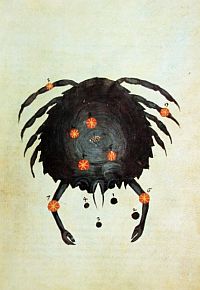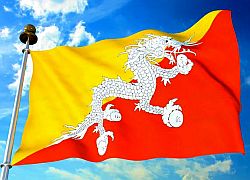Wikipedia
R.H. Allen:
Star Names
Ian Ridpath:
Star Tales
Universe Guide
Sea and Sky:
Constellations
IAU
Map
NASA:
Constellations
|
Wikipedia |
R.H. Allen: Star Names |
Ian Ridpath: Star Tales |
Universe Guide |
Sea and Sky: Constellations |
IAU Map |
NASA: Constellations |


|
|
CancerStar Lore |
|


| Cancer is a constellation in the northern celestial hemisphere. Its name is Latin for crab. |


|
|
Ancient Babylon
The MUL.APIN tables list an asterism called AL.LUL, which
translates to "deceptive digger." J.H. Rogers refers to this entry as "the crab" and "the seat of Anu."
|
 Babylonean turtle amulet
Babylonean turtle amuletSource: British Museum |


|
|
Ancient Egypt
R.H. Allen reports Egyptian
records of about 2000 B.C. in which the constellation Cancer was was described as a sacred Scarabaeus, an emblem of immortality.
|

|


|
|
Ancient Greece Ian Ridpath tells us that the crab "... is a minor character in one of the labours of Heracles. While Heracles was fighting the multi-headed monster called the Hydra in the swamp near Lerna, the crab emerged from the swamp and added its own attack by biting Heracles on the foot. Heracles angrily stamped on the crab, crushing it. For this modest contribution to history, we are told that the goddess Hera, the enemy of Heracles, put the crab among the stars of the zodiac. Its name in Greek was Καρκίνος (Karkinos), or Carcinus in Latin transliteration."
Ian Ridpath also tells us that
Asellus Borealis (γ Cnc) and
Asellus Australis (δ Cnc) have their own legend. They were known to the Greeks as Onoi (Ὄνοι),
the asses;
|
 The crab attacking Heracles, Musee de Louvre, Paris
The crab attacking Heracles, Musee de Louvre, ParisSource: kalofagas.ca
|


|
|
Christian Interpretations of Cancer and Praesepe
In 1627, German lawyer and astronomer Julius Schiller published a star map called
Coelum Stellatum Christianum (The Christian Starry Heaven). It was an (unsuccessful) attempt
to replace the "pagan" constellations with Biblical names and themes.
|
 Sancti Ioannis Apostoli et Evangelistć
Sancti Ioannis Apostoli et EvangelistćSource: Wikipedia
|


|
|
Medieval Islamic Astronomy
According to R.H. Allen, Arab astronomers called
this constellation al saraṭān, meaning "Crab."
Cancer's two main stars still carry Arabic names today. The names of the two other stars are Latinised versions of former Arabic Names. |
 Colored copy of
Colored copy ofal-Sufi's illustration Source: researchgate.net
|

|

|
Official names derived from Arabic origins are shown in bold.
|

Acubens (α Cnc) is derived from the Arabic al-zubanāh, "The Claws."
 Sources: R.H. Allen, Wikipedia.
Tarf (β Cnc) comes from the Arabic al-tarf, meaning "The End. According to
R.H. Allen, the name refers to the end
"...of the southern foot on which it lies." Another translation, also mentioned by Allen refers to the ancient Lion (al-asad)
constellation, interpreting al-tarf as the Glance (of the lion's eye).
Adopting the myth of the Greek gods and their donkeys,
(see above), γ and δ Cancri were collectively known as
al-ḥimārain, "The Two Asses." The name was Latinized to Aselli. Individually, the two stars became
Asellus Borealis, "The Northern Ass" (γ Cnc) and
Asellus Australis, "The Soutern Ass" (δ Cnc).
γ and δ Cancri flank the
Beehive Cluster, an open star cluster that, to the naked eye, looks like a small nebulous object.
(The brightest star in the cluster is ε Cnc. According to Star-Facts,
the name Meleph for this star comes from the Arabic al-ma᾽laf, “the stall.”
|
 Cancer in Pergamenthandschrift M II 141,
a 15th century copy of al-Sufi's drawing;
Source: atlascoelestis.com
Cancer in Pergamenthandschrift M II 141,
a 15th century copy of al-Sufi's drawing;
Source: atlascoelestis.com
|

 an-nathra is also the name of the 8th Arabic Lunar Mansion, formed by the Beehive Cluster, together with γ and δ Cancri.  Source: I. Hafez: Abd al-Rahman al-Sufi and his book of the fixed stars: a journey of re-discovery |


|
|
In ancient Coptic manuscripts, λ Cancri was the center of a
Lunar Station named named
Piautos (πιαυτος). The origin of the name is unknown.  In 2018, the name Piautos was oficially adopted as the proper name for λ Cancri A.  Source: Wikipedia |

|
|
In ancient Persian astronomy, ξ Cancri and
λ Leonis formed the 10th
Lunar Station, called
Nahn, meaning "Nose, referring
to the ancient Lion (al-asad) constellation.
 In 1971, NASA used the name Nahn for ξ Cancri in a technical memorandum containing 537 Named Stars.  In 2018, the name Piautos was oficially adopted as the proper name for ξ Cancri.  Source: Wikipedia, Raham Asha: Lunar Mansions, NASA: A reduced star catalog containing 537 named stars |


|
|
Ancient India
In Hindu Astronomy,
Asellus Borealis (γ Cnc), Asellus Australis (δ Cnc) and
Theta Cancri are the center of the eighth
Nakashtra called Pushya, the nourisher.
|
 Bharata;
Wikipedia
Bharata;
Wikipedia
|


|
|
Ancient China
In Chinese, Cancer is written
巨 蟹 座.
|
 Chinese asterisms in Cancer
Chinese asterisms in CancerMap based on seasky.org |

In the center of Cancer are three Chinese formations, all belonging to the 23rd Lunar Mansion:
Asellus Borealis (γ Cnc), Asellus Australis (δ Cnc) and
Theta Cancri are part of Guǐ, the "Ghost" - the asterism that gave its
name to this Lunar Mansion.
 The Guǐ asterism surrounds the Beehive Cluster, which is called Jīshī, a group of corpses.  According to Ian Ridpath, the Beehive Cluster and its four surrounding stars "...were sometimes seen as a ghost being carried in a sedan chair; hence this quadrilateral was also given the alternative name Yugui, Ghost Wagon." |

Also part of the "Ghost" Mansion is a group of faint stars around
ψ, λ and
χ Cancri. This group is seen as a beacon fire on a watchtower, called Guàn.
 Tegmine (ζ Cnc) lies somewhat outside of the main part of Cancer. It forms an asterism called Shuǐwèi that extends into Canis Minor and is part of the 22nd Lunar Mansion, which is called Jǐng, the Well.  The faint stars in the very north of Cancer, among others σ, τ, ξ and ν Cancri are part of the 25th Lunar Mansion, called Xīng, which means Star. They form a large asterism, that extends into Leo. It is called Xuānyuán which is the given name of the Yellow Emperor, a legendary Chinese sovereign and cultural hero who is said to have reigned from 2698 BC to 2598 BC.  Sources: Wikipedia and Ian Ridpath |
 Yellow Emperor
Yellow EmperorSource: Wikipedia
|


|
Navajo - North America
Navajo astronomy depicts the Beehive Cluster as Tsetah Dibé, the Mountain Sheep.
It is considered a winter constellation, primarily because of its association with the Navajo
winter Nightway ceremony. The constellation is thus visible in the winter months to the naked eye when it is very cold outside and when the moon is
not too bright. The constellation will appear over the evening eastern sky in early winter and will be overhead at dawn.
|

|


|
|
NameExoworlds In the 2015 Name Exoworlds project, a star and a planetary system of five exoplanets in the constellation Cancer received official names. |

  |
The star 55 Cancri A (one of the components of double star 55 Cnc)
was named Copernicus by
the Royal Netherlands Association for Meteorology and Astronomy, Netherlands in honor of Polish
astronomer Nicolaus Copernicus, the developer of the
Heliocentric Model.
 The 55 Cancri planetary system was the first discovery of a system of exoplanets containing more than three planets.  The planets 55 Cnc b, 55 Cnc c, 55 Cnc d, 55 Cnc e and 55 Cnc f were named after Italian astronomer Galileo Galilei, Danish Astronomer Tycho Brahe, German-Dutch telescope maker Hans Lipperhey, Dutch telescope maker Zacharias Janssen and English astronomer Thomas Harriot, respectively, using only their last names.  Source: web.archive.org |
 |

 Galileo
Galileo |
 Brahe
Brahe |
 Lipperhey
Lipperhey |
 Janssen
Janssen |
 Harriot
Harriot |

| All images were taken from their respective Wikipedia sites (see links above) |

| The 2019 NameExoWorld project, in which each country on earth could name one star and one exoplanet, added one additional name for a star and a planet in the Andromeda constellation. |

  |
The Himalayan kingdom Bhutan selected the name
Gakyid, meaning Happiness for star HD 17156.
 Bhutan considers the introduction of the concept of Gross National Happiness as one of its main contributions to the world.  Planet HD 17156 b was named Drukyul, which is the native name of the country, meaning "land of the thunder dragon."  Source: NameExoWorlds Approved Names |
 National Flag of Bhutan
National Flag of BhutanSource: lonelyplanet.com
|


|
Back to Star Lore |
Back to Mythology |
Back to Space Page |
Back to English |
 Back to Start Page |